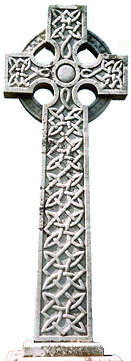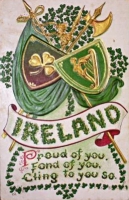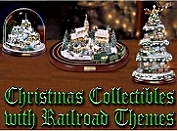| Written by Paul D. Race for Family Christmas OnlineTM |
|
|
Saint Patrick: His People, His Work, and His Day, from Family Christmas OnlineTMI write this at the approach of Saint Patrick's day, in the year 2008. I realize that many people who celebrate St. Patrick's Day are more interested in celebrating Irish heritage and Celtic culture than they are the man Patrick. But that's okay, as there is a lot to celebrate, including Irish contributions to Western culture that are almost completely overlooked. So if you'd like to know what you're really celebrating as you celebrate the culture and/or the saint, read on.Who were the Celts?Most people know that the Irish are a Celtic race (pronounced with a hard C like "Kelt"). But few folks today know that the ancient Celts were fearsome warriors who swept across Europe several times in the days between Alexander the Great and Julius Caesar. Between 600 and 350 BC they invaded - and sometimes settled in - regions as far apart as modern-day Turkey, Portugal, France, Britain, and Ireland. Eventually the military strength of the Celts in most European regions diminished through war and assimilation. By 300 AD, many of the remaining Celts lived in Gaul (modern-day France), while many others lived on the rugged coastlines, raising sheep and sending out raiding parties. Others had migrated to the British Isles to join Celts who had already been there for several centuries. The Britons and the RomansThe Celts in southeast Britain during Julius Caesar's time were called Britons. They couldn't hold the Roman legions off for long, even when they tried their ancient trick of painting themselves blue and charging the enemy naked. Eventually the Britons accepted Roman "protection" and some Roman ideas, including early Christian teachings.On the other hand, the Celts in Ireland and in the western coastal areas and northern mountains of Britain were somewhat more adept at avoiding Roman "civilization" and subsequent invasions of other cultures. So they were better able to retain their language, music, and traditions. The Britons and the EnglishIn the fourth century AD, the Roman legions began withdrawing to deal with problems closer to Rome, which left the now-civilized Britons almost defenseless. Pagan northern peoples such as Angles, Saxons, and Jutes began migrating to England in large numbers. Between 410 and 800AD, the "English," as they came to be called, crowded out, killed, or assimilated many of the Britons and much of their culture with them. On the other hand, some Celtic cultures withstood the English invasion. The Irish, especially, were left alone for centuries, so the local war-lords there were free to raid each other's cattle herds as much as they desired. By then, they had also had a centuries-old reputation for kidnapping the children of Britons to be their slaves. Early Christianity in the British Isles Christianity probably first came to Britain before 100AD, through unnamed Roman soldiers who were also Christian. By the time the Roman Empire became "officially" Christian in 312AD, Christianity had taken root, though it was by no means the only religion. But after the last Roman legion departed Britain about 410AD, the "Saxon invasion" began cutting off most contact between the Christians in the British Isles and the Christians on the continent. Christianity probably first came to Britain before 100AD, through unnamed Roman soldiers who were also Christian. By the time the Roman Empire became "officially" Christian in 312AD, Christianity had taken root, though it was by no means the only religion. But after the last Roman legion departed Britain about 410AD, the "Saxon invasion" began cutting off most contact between the Christians in the British Isles and the Christians on the continent.
At the time the division occurred, the Bishop of Rome was influential, but not necessarily obeyed, nobody prayed to Mary, and the celibacy of the clergy was still considered optional in many regions. Largely cut off from the continental church, the Celtic church wasn't bothered by the fact that it was increasingly "out of step" with new doctrines, dogma, and policies that were consolidating Rome's power and redefining "Christianity" across the Channel. Church leaders blissfully continued to marry, to evangelize, to baptize believers, to ordain clergy, and even to send missionaries to European regions that the Roman church was slow to reach. Patricius' Calling to IrelandSomewhere around 400AD, a young boy from a Christian family in Britain was kidnapped by Irish slavers. According to his own reports, the boy Patricius had not been religious before, but his grandfather and father were clergy, so he knew about God at least. He began calling out to God constantly for help as he lived in the Irish fields and forests, guarding his master's flocks. After several years of captivity and deprivation, he believed he heard God telling him that "his ship was ready." He fled to the seashore and worked his way back to Britain. The trip was difficult but he sensed God working through circumstances more than once. When he reached home, his family begged him to stay. But he could not forget the people among whom he had lived. In spite of his poor Latin skills, Patricius studied hard until he was ordained so that he could go back and tell the Irish about his God.
Historians don't think he really drove the snakes from Ireland - apparently there haven't been any there since the Flood (or since the last ice age, if you prefer). Nobody knows for sure whether he used a three-lobed shamrock to explain the trinity. But we do know that he was fiercely Trinitarian in his beliefs. Still, if you see a statue or painting of a fellow with a shamrock in his hand and a snake under one foot, you should have a pretty good idea of who they're trying to represent. At some point in his later years, Patricius apparently returned to Britain to reply to rumors that were threatening to diminish his authority to continue working in Ireland. We surmise this much because he wrote out his reply, also called a "Confession," in somewhat irregular Latin. As far as we know, he returned to Ireland and spent the rest of his days continuing to evangelize and to encourage his disciples. Patrick's LegaciesTo a Christian, anyone who risks his life for thirty years or more to turn thousands to Christ has all the legacy he needs. But the man we know as Saint Patrick left a cultural legacy as well.By the time of Patrick's death, many of the Irish had gone from being cattle-rustlers and slave traders to being peaceful farmers and scholars. Churches and monasteries (the fifth-century's centers of learning) dotted the landscape. The Irish were using an alphabetic written language, and many Irish youths had learned Latin and Greek. As rough as Irish society still seemed in the eyes of Romanized culture, Ireland was becoming an outpost of civilization and a sanctuary for learning. Perhaps the most important contribution was the work of the Irish scribes. Manuscripts have a "shelf life." Even stored under the best of conditions, they should be copied every so often, lest the next generation find that thousands of years of history have crumbled with the last remaining manuscript. On the continent, political instability (to put it nicely) was slowing down the work of copyists and (some claim) forcing some monasteries to focus on religious books. The Irish monks were reasonably safe, and under no compunction to sort out which books were worth copying. They traveled far and wide, found books wherever they could, and copied almost anything they could get their hands on. Their permanent settlements also spread, to Scotland and then to the continent, especially to modern-day France. According to Cahill's overstated but thought-provoking How the Irish Saved Civilization The Roman Church and the Celtic ChristiansUnfortunately, neither the Celtic churches nor the movement Patrick founded lasted indefinitely. In the late sixth century, missionaries from the Roman church began converting the English (the descendants of the Anglo, Saxon, and Jute immigrants/invaders). Of course, the Roman missionaries couldn't help bumping into the "native" Christians. Nor could they help feeling uncomfortable with the hundreds of thriving Christian communities that didn't answer to Rome and saw no reason to follow doctrines, dogmas, and regulations that had entered the Roman church since the third century AD. Roman church leaders were also appalled at the married clergy, at the monasteries' lax discipline, at the lack of emphasis on Original Sin, and at the Celtic monk's haircuts, which looked silly to the monks on the continent.When the time came to discuss reconciliation between the Roman and Celtic Christians, several points of serious disagreement could have been debated. But according to historical records, most of the emphasis seemed to be on when Easter should be celebrated. Without too much fuss, most of the Irish church leaders capitulated on when to celebrate Easter (and most other points of difference) by the year 697. The Irish monks changed their haircuts, and Ireland became Roman Catholic almost overnight. In return, Ireland got to keep her patron saint. (Clergy in the British Isles continued to marry for another four centuries, but that's another story.) Sadly, many of Patrick's reforms, especially literacy, were reversed by later imperialism. After the English did invade Ireland, most Irish were denied the rights to read, to live above abject poverty, or even to speak their own language. Centuries of such treatment should have broken the Irish spirit forever. But Irish music, culture, and self-identity survived, and beginning in the 1800s, actually revived. The Irish Reach AmericaWhen poverty and famine drove nearly a million Irish people to our shores in the 1800s, they really were "tired, poor, and yearning to breath free." So many uneducated laborers flooded the workplaces of America that bigotry flourished and "No Irish Need Apply" signs appeared on many businesses. Yet most Irish immigrants adapted quickly, took the jobs nobody else wanted, and found their place in the new land. to breath free." So many uneducated laborers flooded the workplaces of America that bigotry flourished and "No Irish Need Apply" signs appeared on many businesses. Yet most Irish immigrants adapted quickly, took the jobs nobody else wanted, and found their place in the new land.
Today Americans of Irish descent celebrate, not only their Irish heritage, but also their Irish-American heritage. If you're an Irish American whose great-great-grandparents came from Ireland with nothing but the shirts on their backs to make a life for themselves, you should feel proud. Patrick, the Saint
The Roman church notwithstanding, it's not hard to see why Irish Christians of all sorts still see Patrick (or St. Paddy) as their own spiritual and cultural hero. A Celt himself (half Briton, according to tradition), he lived alongside them, lay his life down for them and brought them "out of the miry clay" of ignorance, slavery, and constant warfare. "You can have your stuffy Latin scholars like Augustine; give us a saint with dirt under his fingernails." Patrick is supposed to have died on March 17, which is now celebrated as his feast day in the church. In honor of "the Apostle to the Irish," March 17 has long been a national holiday in Ireland, though celebrating the feast is optional in the rest of the world. The year 2008 saw the Roman Catholic bishops in Ireland change the religious feast day from March 17 to March 15, so it would not compete with Easter week. Don't worry; folks in Ireland still get a day off work on March 17. Also, Saint Patrick's day shouldn't fall during Holy week again until AD2160, so I'm not too worried that this will become a pattern in my lifetime. A more frequent problem occurs when St. Patrick's feast falls on a Friday during Lent - technically no meat is allowed. Some dioceses have been known to allow exceptions, so Irish families can still eat a traditional corned-beef-and-cabbage meal on the saint's feast day. So if you're a devout Catholic, check with your bishop before you plan your Saint Patrick's Day menu in 2017, 2023, and so on. Don't Overdo ItIn parts of the United States, Saint Patrick's day started out as a reason for the Irish to celebrate, then became a reason to celebrate being Irish, and now is a reason to party, period. Unfortunately the third aspect of Saint Patrick's day causes many Irish nationals to wince and to hope that we don't export that particular tradition to the "Old Country." For some reason, they don't believe that falling down drunk really honors either the saint or their cultural heritage. If YOU think it's appropriate, at least make certain you have a short walk home or a designated driver.What to CelebrateYou can see that Patrick's life and example gives us much to commemorate:
How To Celebrate (Appropriately)
If you can think of other ways to celebrate Saint Patrick's Day appropriately, please contact us, and we'll try to add it to the list. Other Resources
Happy Saint Patrick's Day - Thanks for stopping by. God grant you and your loved ones grace and a spirit of generosity and service this season. And in the meantime:
May the road rise to meet you,
Paul D. Race, Family Christmas Online If you have any corrections, comments, or additions you would like to make about this article, please contact me and I will be glad to hear from you. God bless - Paul These are only a beginning. There is so much great Celtic music on CD I almost don't know where to start, but here are a few nice pieces, as well as some movies with Irish-related themes.
|



|
To return to the Christmas Musings page, click here.
To return to the Family Christmas OnlineTM Home Page, click here.


| 
| 
| 
| 
|
Note: Family Christmas OnlineTM is a trademark of Breakthrough Communications(tm) (www.btcomm.com).
All information, data, text, and illustrations on this web site are
Copyright (c) 2006, 2007, 2008, 2009, 2010, 2011, 2012, 2013, 2014, 2015 by Paul D. Race.
Reuse or republication without prior written permission is specifically
forbidden.
Family Christmas Online(tm) is a participant in the Amazon Services LLC Associates Program, an affiliate advertising program designed to provide a means for sites to earn advertising fees by advertising and linking to amazon.com.
For more information, please contact us
| Visit our affiliated sites: | ||||||
| - Christmas Memories and Collectibles - | ||||||
 |

|

|

|

|

|
|
| - Family Activities and Crafts - | ||||||
 |

|

|

|

|

|
|
| - Trains and Hobbies - | ||||||

|

|

|  |

|
 |
|
| - Music - | ||||||

|

|
 |

|

|
 |
|